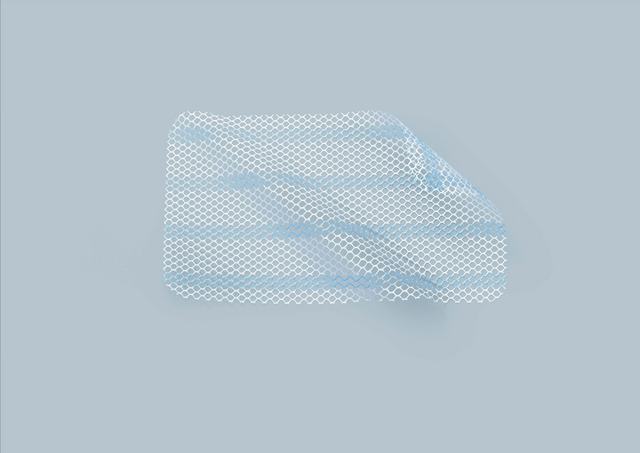TiLENE® Blue Mesh

Benefits
Body compatibility
Titanium’s body compatibility properties transferred to a hernia mesh.
Quality of life
Improved quality of life for patients.1
Handling
Easier handling and excellent visibility
Standardisation
TiLENE® Blue Mesh is suitable for all intra- and extraperitoneal hernias and surgical techniques incl. IPOM. Only a few mesh variants suffice to cover all needs of general and visceral surgery.
Time and cost savings
The hydrophilic surface of TiLENE® Blue Mesh facilitates the handling during laparoscopic surgery. Furthermore, certain indications do not require fixation.2,3 Consequently, the entire procedure becomes more time and cost efficient.
Easier alignment of the mesh
The blue orientation stripes facilitate the alignment of the mesh implant.
No effect on diagnostics
Imaging diagnostics are not affected.
[1] Horstmann R., Hellwig M., Classen C., Röttgermann S., Palmes D., Impact of polypropylene amount on functional outcome and quality of life after inguinal hernia repair by the TAPP procedure using pure, mixed, and titanium-coated meshes. World J Surg, 2006, 30(9): 1742-1749
[2] Tamme C., Garde N., Klingler A., Hampe C., Wunder R., Köckerling F., Totally extraperitoneal inguinal hernioplasty with titanium-coated lightweight polypropylene mesh: early results. Surg Endosc, 2005, 19(8): 1125-1129
[3] Bittner R., Schmedt C. G., Leibl B. J., Schwarz J., Early postoperative and one year results of a randomized controlled trial comparing the impact of extralight titanized polypropylene mesh and traditional heavyweight polypropylene mesh on pain and seroma production in laparoscopic hernia repair (TAPP). World J Surg, 2011, 35(8): 1791–1797
Technical Data
- Material: Titanised type 1a polypropylene mesh
- Pore size: 3 mm
- Product weight: 24 g/m²
Knowledge
Highest demands on the material
In addition to the skills of the surgeon, the quality of the mesh material determines the quality of a lasting and anatomically stable hernia repair. TiMESH mesh implants are made of Type 1a polypropylene mesh (macroporous & monofilament)1 with a titanised, hydrophilic surface. Compared to simple polypropylene, this offers a number of advantages, which are already known in the use of titanised mesh implants for hernia surgery, such as:
- better cell growth2
- lower risk of inflammation3
- less scarring3
- less shrinkage of the mesh4
[1] Klinge et al. Modified classification of surgical meshes for hernia repair based on the analyses of 1,000 explanted meshes. Hernia (2012) 16: 251–258
[2] Lehle K. Lohn S., Verbesserung des Langzeitverhaltens von Implantaten und anderen Biomaterialien auf Kunststoffbasis durch plasmaaktivierte Gasphasenabscheidung (PACVD), Abschlussbericht Forschungsverbund “Biomaterialien (FORBIOMAT II)”, 149–173, 2002
[3] Scheidbach et al. In vivo studies comparing the biocompatibility of various polypropylene meshes and their handling properties during endoscopic total extraperitoneal (TEP) patchplasty. Surg Endosc (2004) 18: 211–220
[4] Scheidbach et al. Influence of Titanium Coating on the Biocompatibility of a Heavyweight Polypropylene Mesh. Eur Surg Res 2004; 36: 313–317
Application area
- All hernia types including IPOM
Manufacturer
- pfm medical titanium gmbh, Südwestpark 42, 90449 Nuremberg, Germany
Ordering Information
| Article number | Size | Delivery unit (VPE) |
|---|---|---|
| 6000950 | 10 cm x 15 cm | 3 pcs |
| 6000951 | 15 cm x 15 cm | 3 pcs |
| 6000952 | 20 cm x 15 cm | 3 pcs |
| 6000953 | 30 cm x 30 cm | 1 pcs |
Downloads
- IPOM vs Sublay (Köckerling at al) | Study Summary (PB4105EN)
- Benefits of Titanisation | Brochure (PB4104EN)
- Hernia Meshes | Scientific Publications (PB4102EN)
Instructions for use can be found in our Download Center.
Additional information

Please note:
Not all products are available in every country.
Please refer to the respective country websites:
For all other countries please use the contact form to enquire about availability for your country.